Regulatory Compliance & Human Error: Navigating the Human Factor in 2025's Evolving Cybersecurity Landscape
Building Defense-Grade Compliance While Minimizing Human Risk
As we advance into 2025, the cybersecurity compliance landscape continues to evolve at breakneck speed. For organizations in defense, healthcare, manufacturing, and pharmaceutical sectors, staying ahead of regulatory requirements while managing the inevitable human factor has become more critical (and more challenging) than ever. At Dragnet, we've seen firsthand how human error can derail even the most well-intentioned compliance efforts, but we've also witnessed how organizations can transform this challenge into a competitive advantage.
The reality is stark: while technology advances and threats become more sophisticated, humans remain both the strongest defense and the weakest link in any compliance program. Understanding how to navigate this paradox is essential for organizations seeking to maintain robust cybersecurity postures while meeting increasingly stringent regulatory demands.
2025 Compliance Update: What's Changed and How to Adapt
The regulatory landscape of 2025 has brought significant changes that directly impact how organizations approach compliance and human risk management. The most notable development is the full implementation of CMMC 2.0, which became effective on December 16, 2024, fundamentally changing the compliance game for defense contractors and their supply chains.
CMMC 2.0: The New Reality
With CMMC 2.0 now in full effect, defense contractors face a "trust but verify" approach that demands more than just policy documentation. The program requires demonstrable evidence that cybersecurity practices are consistently implemented and maintained. This shift has profound implications for managing human error, as every employee action must align with documented policies and technical controls.
The three-tiered CMMC structure Level 1 (17 practices), Level 2 (110 practices based on NIST 800-171), and Level 3 (additional 24 enhanced practices from NIST 800-172)—creates varying compliance burdens that organizations must navigate while ensuring their workforce understands and consistently follows required procedures.
Evolving NIST Standards and Human-Centric Controls
NIST has continued refining its approach to password management and access controls, recognizing that overly complex requirements often lead to human error. The current recommendations emphasize longer passphrases over frequent changes, acknowledging that forcing users to constantly update passwords often results in weaker, more predictable credentials.
These changes reflect a growing understanding that compliance frameworks must account for human psychology and behavior patterns. Organizations that adapt their compliance strategies to work with human nature, rather than against it, see significantly better outcomes.
Regulatory Harmonization Challenges
As multiple frameworks CMMC, NIST 800-171, HIPAA, and industry-specific regulations continue to evolve, organizations face the challenge of harmonizing compliance efforts across different standards. This complexity increases the likelihood of human error, as employees struggle to understand which requirements apply in different contexts.
Automating Compliance: From Burden to Business Advantage
The key to managing human error in compliance lies not in eliminating the human element, but in strategically automating routine tasks while empowering employees to focus on higher-value activities that require human judgment and creativity.
Strategic Automation Implementation
Effective compliance automation begins with identifying repetitive, rule-based tasks that are prone to human error. These include:
Policy Enforcement Automation: Rather than relying on employees to remember complex access control rules, automated systems can enforce role-based access controls (RBAC) that dynamically adjust permissions based on job functions, time of day, and data sensitivity levels.
Documentation and Evidence Collection: Automated systems can capture screenshots, system logs, audit trails, and configuration reports required for CMMC audits, removing the burden from employees while ensuring consistent, comprehensive documentation.
Continuous Monitoring and Alerting: Automated monitoring systems can detect policy violations or suspicious activities in real-time, allowing for immediate corrective action rather than waiting for periodic manual reviews.
The Business Advantage of Compliance Automation
When implemented strategically, compliance automation transforms from a cost center into a business advantage. Organizations report several key benefits:
Reduced Compliance Costs: By automating routine compliance tasks, organizations can reassign human resources to strategic initiatives while maintaining or improving compliance postures.
Faster Response Times: Automated incident response plans can trigger immediate containment measures while human experts focus on analysis and strategic decision-making.
Improved Audit Readiness: Continuous automated documentation ensures organizations are always audit-ready, reducing the stress and resource drain of compliance assessments.
Enhanced Competitive Position: Organizations with mature compliance automation can respond to RFPs faster and with greater confidence, knowing their compliance posture is consistently maintained.
Human-Automation Partnership
The most successful compliance programs don't replace humans with automation—they create partnerships where each complements the other's strengths. Humans excel at contextual decision-making, creative problem-solving, and adapting to novel situations, while automation handles routine monitoring, documentation, and enforcement tasks.
Human Error in Compliance Violations: Prevention Strategies
Understanding the root causes of human error in compliance violations is essential for developing effective prevention strategies. Our experience working with defense contractors, healthcare organizations, and manufacturers has revealed several common patterns.
Common Human Error Patterns
Configuration Drift: Employees make small system changes that individually seem harmless but collectively compromise security postures. This often occurs when urgent operational needs override security protocols.
Policy Interpretation Errors: Complex compliance requirements lead to inconsistent interpretation and implementation across teams. Different departments may understand the same requirement differently, creating compliance gaps.
Training Decay: Even well-trained employees gradually forget specific procedures over time, especially for tasks performed infrequently. This is particularly problematic for incident response procedures that are rarely needed but critical when required.
Social Engineering Susceptibility: Despite training, employees remain vulnerable to sophisticated phishing attacks and social engineering attempts that can compromise compliance efforts.
Proven Prevention Strategies
Clear, Actionable Documentation: Compliance policies must be written in plain language that all stakeholders can understand, regardless of technical expertise. Avoid jargon and provide specific, step-by-step procedures for common tasks.
Regular, Scenario-Based Training: Move beyond annual compliance training to regular, scenario-based exercises that help employees practice applying compliance requirements in realistic situations. This approach helps embed compliance thinking into daily operations.
Layered Verification Systems: Implement multiple checkpoints for critical compliance activities. For example, require dual approval for access changes and automated verification of policy compliance before implementation.
Positive Reinforcement Programs: Recognize and reward employees who identify potential compliance issues or suggest improvements to existing processes. This creates a culture where compliance is seen as everyone's responsibility rather than a burden.
Error-Friendly Systems: Design systems and processes that make it difficult to accidentally violate compliance requirements. For example, use default settings that favor security and require explicit actions to reduce protection levels.
Learning from Near-Misses
Establish formal processes for capturing and analyzing near-miss incidents where human error almost led to compliance violations. These events provide valuable insights into system weaknesses and human factors that might not be apparent during normal operations.
Building Compliance into Everyday Workflows: The Human Factor
The most effective compliance programs seamlessly integrate requirements into everyday workflows, making compliance a natural part of how work gets done rather than an additional burden layered on top of existing processes.
Workflow Integration Principles
Start with Current Processes: Rather than forcing employees to adopt entirely new workflows, identify how compliance requirements can be integrated into existing processes. This reduces resistance and increases adoption rates.
Make Compliance the Easy Choice: Design workflows where the compliant action is also the most convenient action. For example, use single sign-on systems that provide secure access while reducing password fatigue.
Provide Real-Time Guidance: Integrate compliance guidance directly into the systems employees use daily. Context-sensitive help and automated prompts can guide employees toward compliant actions without interrupting their workflow.
Leverage Existing Habits: Build on habits employees already have rather than trying to create entirely new behaviors. For example, integrate security checks into existing quality assurance processes.
Creating a Compliance-Conscious Culture
Leadership Modeling: Leaders must consistently demonstrate compliance behaviors in their daily actions. When employees see executives following the same procedures they're required to follow, compliance becomes part of the organizational culture rather than just a set of rules.
Cross-Functional Collaboration: Break down silos between compliance, IT, and operational teams. Regular collaboration ensures that compliance requirements are understood and supported across the organization.
Continuous Feedback Loops: Establish mechanisms for employees to provide feedback on compliance processes and suggest improvements. This helps identify friction points that might lead to workarounds or violations.
Celebrating Compliance Success: Recognize teams and individuals who successfully maintain compliance while achieving operational objectives. This reinforces the message that compliance and performance are complementary, not competing priorities.
Practical Implementation Strategies
Phased Rollout: Implement compliance workflow changes gradually, allowing employees to adapt and providing opportunities to refine processes based on real-world feedback.
Champion Networks: Identify and train compliance champions in each department who can provide peer support and help troubleshoot compliance challenges as they arise.
Regular Process Reviews: Conduct quarterly reviews of compliance workflows to identify areas where human error is occurring and adjust processes accordingly.
Technology Integration: Use workflow management tools that can enforce compliance checkpoints while maintaining operational efficiency.
The Path Forward: Building Resilient Compliance Programs
As we navigate the evolving compliance landscape of 2025 and beyond, organizations must recognize that human error is not a problem to be solved but a reality to be managed. The most successful compliance programs acknowledge human limitations while leveraging human strengths, creating systems that are both robust and adaptable.
The key lies in understanding that compliance is not just about meeting regulatory requirements; it's about building organizational resilience that protects sensitive data, maintains client trust, and enables sustainable growth. When compliance becomes integrated into everyday workflows and supported by appropriate automation, it transforms from a burden into a competitive advantage.
Organizations that master this balance, leveraging automation for routine tasks while empowering humans to focus on strategic thinking and creative problem-solving, will not only meet today's compliance requirements but be better positioned to adapt to future regulatory changes.
At Dragnet, we've seen how defense-grade cybersecurity principles can be successfully applied across industries, creating compliance programs that are both effective and sustainable. The organizations that thrive in 2025's regulatory environment will be those that view compliance not as a checkbox exercise but as an integral part of their operational excellence strategy.
The future of compliance lies in this human-technology partnership where automated systems handle routine monitoring and enforcement while humans focus on the strategic thinking, creative problem-solving, and adaptive decision-making that no algorithm can replace. By building this partnership thoughtfully, organizations can create compliance programs that not only meet regulatory requirements but actively contribute to their competitive advantage in an increasingly complex digital landscape.
You May Also Like
These Related Stories

RVAsec 14 Wrap-Up: A Phenomenal Success for the Cybersecurity Community

How Can Businesses Integrate Penetration Testing into Their Cybersecurity Strategy and Culture?
.png)



